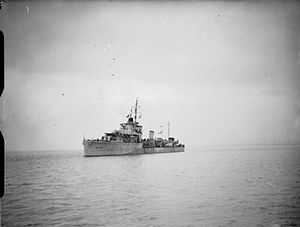HMCS Qu'Appelle (H69)
 HMCS Qu'Appelle. | |
| Career (UK) | |
|---|---|
| Name: | HMS Foxhound |
| Ordered: | 17 March 1933 |
| Builder: | John Brown & Company, Clydebank |
| Laid down: | 21 August 1933 |
| Launched: | 12 October 1934 |
| Commissioned: | 6 June 1935 |
| Decommissioned: | 8 February 1944 |
| Fate: | Transferred to the Royal Canadian Navy |
| Notes: | Colours:White and blue |
| Badge: | Blazon Azure, a bend wavy argent charged with a like bendlet gules, and over all a fox's mask argent. |
| Career (Canada) | |
| Name: | HMCS Qu'Appelle |
| Acquired: | 8 February 1944 |
| Commissioned: | 8 February 1944 |
| Decommissioned: | 27 May 1946 |
| Honours and awards: |
Atlantic, 1944 Normandy, 1944 Biscay, 1944 |
| General characteristics | |
| Class & type: | River-class destroyer |
| Displacement: |
1,405 long tons (1,427.5 t) standard 1,940 long tons (1,971.1 t) deep |
| Length: | 329 ft (100.3 m) o/a |
| Beam: | 33.3 ft (10.1 m) |
| Draught: | 10.8 ft (3.3 m) |
| Propulsion: | 3 x Admiralty 3-drum water tube boilers, Parsons geared steam turbines, 38,000 shp on 2 shafts |
| Speed: | 35.5 kn (65.7 km/h), 31.5 kn (58.3 km/h) deep |
| Range: |
6,350 nmi (11,760 km) at 15 kn (27.8 km/h) 1,275 nmi (2,361 km) at 35.5 kn (65.7 km/h) |
| Complement: | 145 |
| Armament: |
|
HMCS Qu'Appelle (H69) was a River-class destroyer that served the Royal Canadian Navy from 1944-1946.
She was laid down on 21 August 1933 at John Brown Shipbuilding & Engineering Company Ltd., Clydebank, and launched on 12 October 1934. She was commissioned into the Royal Navy on 6 June 1935 as an Interwar standard E and F-class destroyer with the name HMS Foxhound (H69).[1]
Foxhound was converted to a long-range escort from August 1943, and on completion she was decommissioned by the Royal Navy on 8 February 1944 and transferred to Canada; she was commissioned into the Royal Canadian Navy on that day as HMCS Qu'Appelle (H69).[2][3] Qu'Appelle formed part of the 12th Escort Group in June 1944, with the role of protecting shipping from German attacks during the Normandy landings,[4] and together with the destroyers Saskatchewan, Skeena and Restigouche, attacked three German patrol boats off Brest on the night of 5–6 July, with the German patrol boat V715 being sunk.<ref name=""Rohwer p290">Rohwer and Hümmelchen 1992, p. 290.</ref> On 11 August Qu'Appelle together with Restigouche , Skeena and Assiniboine was ordered to intercept German shipping escaping from the Biscay ports. While she sank two trawlers, Qu'Appelle was damaged by collision with Skeena and was under repair until September, when she joined the 11th Escort Group for patrols off Iceland.[5] She was decommissioned from the RCN on 27 May 1946.
References
- English, John. Amazon to Ivanhoe: British Standard Destroyers of the 1930s. Kendal, UK: World Ship Society, 1993. ISBN 0-905617-64-9.
- Rohwer, Jürgen and Gerhard Hümmelchen. Chronology of the War at Sea 1939–1945. London: Greenhill Books, 1992. ISBN 1-86367-117-7.
- Whitley, M. J. Destroyers of World War Two: An International Encyclopedia. London: Cassell & Co, 2000. ISBN 1-85409-521-8.
- uboat.net : F class destroyers
- uboat.net : HMS Foxhound (H69)
- Hazegrey.org
| |||||||||||||||||||||||||||
| |||||||||||||||||||||||||||||